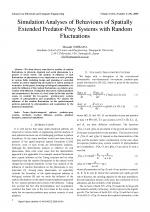| 1/2008 - 1 | View TOC | « Previous Article | Next Article » |
Simulation Analyses of Behaviours of Spatially Extended Predator-Prey Systems with Random FluctuationsISHIKAWA, M. |
| Extra paper information in |
| Click to see author's profile in |
| Download PDF |
Author keywords
spatio-temporal pattern, predator-prey systems, stochastic reaction diffusion systems, plankton dynamics, numerical simulations
References keywords
pattern(7), formation(7), temporal(4), spatio(4), petrovskii(4), malchow(4), dynamics(4)
No common words between the references section and the paper title.
About this article
Date of Publication: 2008-04-02
Volume 8, Issue 1, Year 2008, On page(s): 2 - 6
ISSN: 1582-7445, e-ISSN: 1844-7600
Digital Object Identifier: 10.4316/AECE.2008.01001
Web of Science Accession Number: 000259903500001
SCOPUS ID: 77955613114
Abstract
We often observe some kind or another of random fluctuations in physical, chemical and social phenomena to a greater or lesser extent. The analysis of influence of such fluctuations on phenomena is very important as a basic problem in various fields including design and planning of controlled systems in control engineering and analysis of option pricing in economics. In this paper, focusing on biological communities, we study the influence of the random fluctuations on predator-prey systems with diffusion. Noting that interaction of phytoplankton and zooplankton is the basis of a food chain in the lake and the ocean, we consider the two-species predator-prey systems consists of phytoplankton and zooplankton. We analyze the influence of the random fluctuations on the spatio-temporal patterns generated by phytoplankton and zooplankton by the numerical simulations. |
| References | | | Cited By «-- Click to see who has cited this paper |
| [1] Walgraef D., Spatio-Temporal Pattern Formation, Springer-Verlag, 1997. [CrossRef] [2] Murray J. D., Mathematical Biology I, II, Springer-Verlag, 2001. [3] Meinhardt H., Algorithmic Beauty of Sea Shells, 3rd ed., Springer-Verlag, 2003. [4] Meinhardt H., Models of Biological Pattern Formation, Academic Press, 1982. [5] Mansour M. B. A., Traveling Wave Solutions of a Nonlinear Reaction-diffusion-chemotaxis Model for Bacterial Pattern Formation, Applied Mathematical Modelling, 32 (2), pp. 240-247, 2008. [CrossRef] [Web of Science Times Cited 24] [SCOPUS Times Cited 27] [6] Khain E. and Sander L. M., Dynamics and Pattern Formation in Invasive Tumor Growth, Physical Review Letters, 96 (18), art. no. 188103, 2006. [CrossRef] [Web of Science Times Cited 83] [SCOPUS Times Cited 88] [7] Vicsek T., Fluctuations and Scaling in Biology, Oxford Univ. Press, 2001. [8] Gottelli N. J., A Primer of Ecology, Sinauer Associates, 2001. [9] Petrovskii S. V. and Malchow H., Wave of Chaos: New Mechanism of Pattern Formation in Spatio-temporal Population Dynamics, Theoretical Population Biology 59, 157-174, 2001. [CrossRef] [PubMed] [Web of Science Times Cited 176] [SCOPUS Times Cited 195] [10] Petrovskii S. V. and Malchow H., A Minimal Model of Pattern Formation in a Prey-Predator System, Mathematical and Computer Modelling, 29, 49-63, 1999. [CrossRef] [Web of Science Times Cited 157] [SCOPUS Times Cited 165] [11] Medvinskii A. B., Petrovskii S. V. and Malchow H. et al., Spatio-temporal Pattern Formation, fractals, and Chaos in Conceptual Ecological Models as applied to Coupled Plankton-fish Dynamics, Physics-Uspekhi, 45 (1), pp.27-57, 2002. [CrossRef] [Web of Science Times Cited 25] [SCOPUS Times Cited 25] [12] Medvinsky A. B., Petrovskii S. V., I. A. Tikhonova, Malchow H. and Li B-L., Spatio-temporal Complexity of Plankton and Fish Dynamics, SIAM Review, 44, (3), pp.311-370, 2002. [CrossRef] [Web of Science Times Cited 425] [SCOPUS Times Cited 457] [13] Kallianpur G. and Xiong, J., Stochastic Differential Equations in Infinite Dimensional Spaces, IMS Lecture Notes-Monograph Series, Institute of Mathematical Statistics, Vol. 26, 1995. [14] Mikosch T., Elementary Stochastic Calculus with Finance in View, World Scientific Publishing, 1998. [CrossRef] Web of Science® Citations for all references: 890 TCR SCOPUS® Citations for all references: 957 TCR Web of Science® Average Citations per reference: 64 ACR SCOPUS® Average Citations per reference: 68 ACR TCR = Total Citations for References / ACR = Average Citations per Reference We introduced in 2010 - for the first time in scientific publishing, the term "References Weight", as a quantitative indication of the quality ... Read more Citations for references updated on 2025-06-03 16:30 in 59 seconds. Note1: Web of Science® is a registered trademark of Clarivate Analytics. Note2: SCOPUS® is a registered trademark of Elsevier B.V. Disclaimer: All queries to the respective databases were made by using the DOI record of every reference (where available). Due to technical problems beyond our control, the information is not always accurate. Please use the CrossRef link to visit the respective publisher site. |
Faculty of Electrical Engineering and Computer Science
Stefan cel Mare University of Suceava, Romania
All rights reserved: Advances in Electrical and Computer Engineering is a registered trademark of the Stefan cel Mare University of Suceava. No part of this publication may be reproduced, stored in a retrieval system, photocopied, recorded or archived, without the written permission from the Editor. When authors submit their papers for publication, they agree that the copyright for their article be transferred to the Faculty of Electrical Engineering and Computer Science, Stefan cel Mare University of Suceava, Romania, if and only if the articles are accepted for publication. The copyright covers the exclusive rights to reproduce and distribute the article, including reprints and translations.
Permission for other use: The copyright owner's consent does not extend to copying for general distribution, for promotion, for creating new works, or for resale. Specific written permission must be obtained from the Editor for such copying. Direct linking to files hosted on this website is strictly prohibited.
Disclaimer: Whilst every effort is made by the publishers and editorial board to see that no inaccurate or misleading data, opinions or statements appear in this journal, they wish to make it clear that all information and opinions formulated in the articles, as well as linguistic accuracy, are the sole responsibility of the author.



